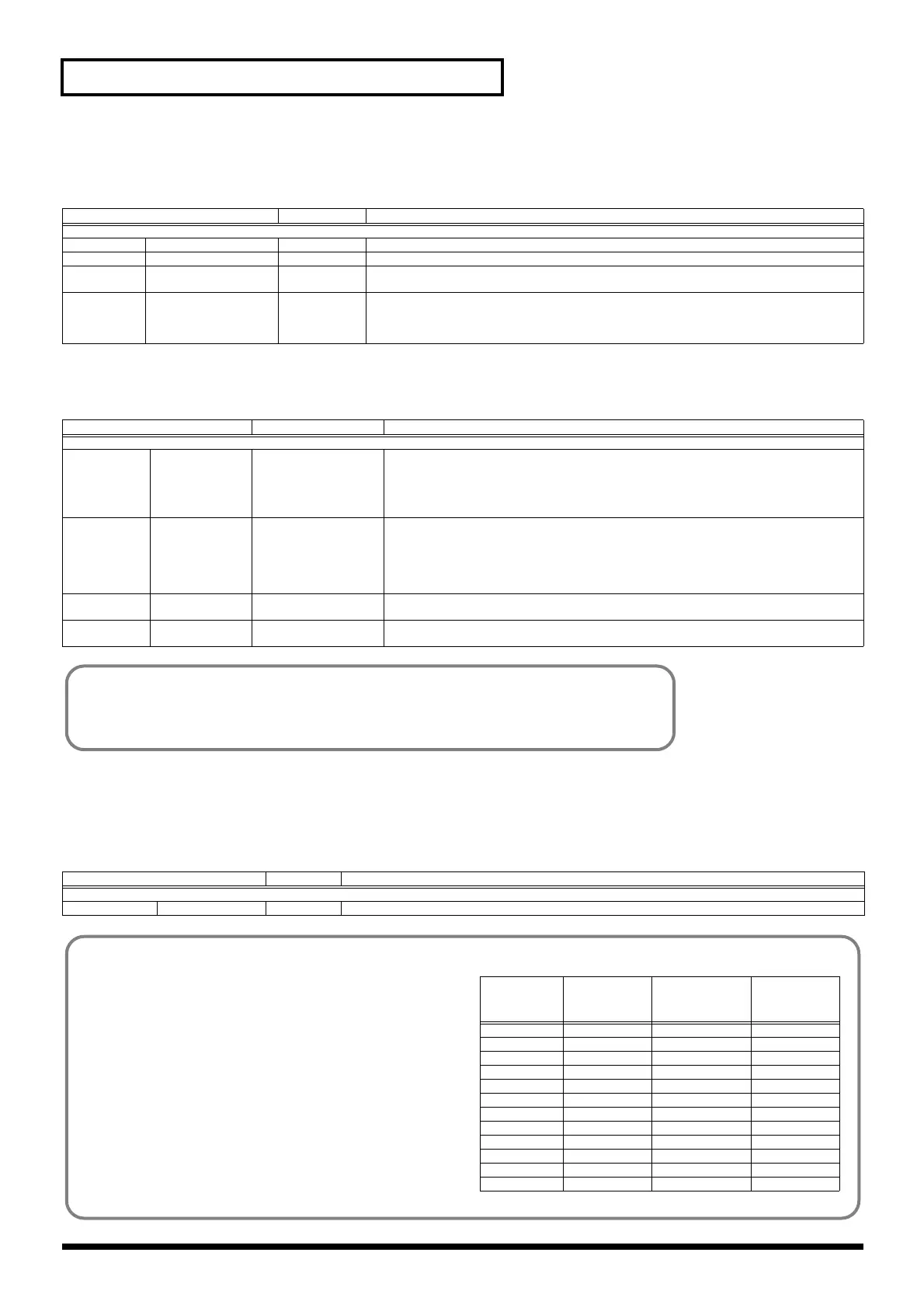66
Chapter 3 Creating a Performance
Changing the Pitch
You can set the pitch and bend range each Part uses when playing its sound.
Changing the Way a Part’s Sound is Played
You can set the MONO/POLY, Legato and Portamento each Part uses when playing its sound.
Scale Tune
The XV-5050 allows you to use temperaments other than equal temperament.
One set of Scale Tune settings can be created in Patch mode. In Performance mode, each Part can have its own Scale Tune settings.
* The selected scale applies to MIDI messages received from an external MIDI device as well as to local sound generation.
Parameter
Value Description
PART
Octave Shift
Part Octave Shift -3–+3 Adjusts the pitch of the Part’s sound up or down in units of an octave (+/-3 octaves).
Coarse Tune Part Coarse Tune -48–+48 Adjusts the pitch of the Part’s sound up or down in semitone steps over a range of +/-4 octaves.
Fine Tune Part Fine Tune -50–+50 Adjusts the pitch of the Part’s sound up or down in 1-cent steps (1/100th of a semitone) over a range
of half a semitone up or down.
Bend Range Part Pitch Bend Range 0–24, PATCH Specifies the amount of pitch change that occurs when you move the Pitch Bend Lever. This overrides
the sound’s own pitch-bend settings. The amount of pitch change downward or upward that occurs
when the lever is moved is the same for both its left and right directions (or down and up on some
MIDI controllers). When PATCH is chosen, the bend range settings for the assigned Patch take effect.
Parameter
Value Description
PART
Mono/Poly
Part Mono/Poly MONO, POLY, PATCH Sets how the Patch’s notes play. The MONO setting is effective when playing a solo instrument
Patch such as sax or flute.
MONO:
Only one note sounds at a time.
POLY:
Two or more notes can be played simultaneously.
PATCH:
The Part uses the Patch’s Mono/Poly setting.
Legato Switch Part Legato
Switch
OFF, ON, PATCH Turn this parameter on when you want to use the Legato feature and off when you don’t. Legato
is a feature that works only when the Key Assign Mode is MONO. When Legato is ON, pressing
one key when another is already pressed causes the currently playing note’s pitch to change to
that of the newly pressed key while continuing to sound. This can be effective when you wish to
simulate performance techniques such as a guitarist’s hammering on and pulling off strings.
When PATCH is selected, the Patch’s own settings take effect.
Portamento
SW
Part Portamento
Switch
OFF, ON, PATCH Specifies whether the portament effect is applied (ON) or not (OFF). When PATCH is selected,
the settings for the assigned Patch take effect.
Portamento
Time
Part Portamento
Time
0–127, PATCH Specifies the time over which the pitch changes. Higher settings cause the pitch change to the next
note to take more time. When PATCH is chosen, the settings for the assigned Patch take effect.
Parameter
Value Description
PART
Key C–B Scale
Key Scale C–B -64– +63 Adjusts the pitch of each note in one-cent steps (1/100th of a semitone) relative to its equal-tempered pitch.
What is Portamento?
Portamento is an effect that smoothly changes the pitch from the first-played key to the next-played key.
When Key Assign is MONO, applying portamento produces an effect similar to the slide performance
technique of a violinist. Portamento can also be applied when Key Assign is polyphonic (POLY).
<Equal Temperament>
This scale divides an octave into 12 equal parts using the tuning
system that is most widely used in Western music.
<Pure Temperament>
With this tuning, the three fundamental chords sound richer
compared to equal temperament. This effect only applies to one
key, and transposition can produce less-pleasing results.
<Arabian Scale>
In this scale, E and B are a quarter note lower, and C#, F# and G#
are a quarter-note higher compared to equal temperament. The
intervals between G and B, C and E, F and G#, Bb and C#, and Eb
and F# have a natural third-the interval between a major third and
a minor third. On the XV-5050, you can use Arabian temperament
in the three keys of G, C and F.
Example: Tonic C
Note name Equal tem-
perament
Pure temper-
ament
Arabian
scale tem-
perament
C 0 0 -6
C# 0 -8 +45
D 0 +4 -2
Eb 0 +16 -12
E 0 -14 -51
F 0 -2 -8
F# 0 -10 +43
G 0 +2 -4
G# 0 +14 +47
A 0 -16 0
Bb 0 +14 -10
B 0 -12 -49
XV-5050_e.book 66 ページ 2003年6月27日 金曜日 午後3時14分
